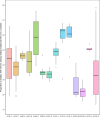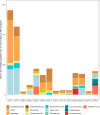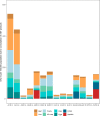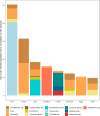Global disease burden of pathogens in animal source foods, 2010
- PMID: 31170162
- PMCID: PMC6553721
- DOI: 10.1371/journal.pone.0216545
Global disease burden of pathogens in animal source foods, 2010
Abstract
Animal source foods (ASF) such as dairy, eggs, fish and meat are an important source of high-quality nutrients. Lack of ASF in diets can result in developmental disorders including stunting, anemia, poor cognitive and motor development. ASF are more effective in preventing stunting than other foods and promoting ASF consumption in low- and middle-income countries could help improve health, particularly among pregnant women and young children. Production and consumption of ASF are, however, also associated with potential food safety risks. Strengthening of food control systems, informed by quantitative assessments of the disease burden associated with ASF is necessary to meet global nutrition goals. We present the human disease burden associated with 13 pathogens (bacteria and parasites) in ASF, based on an analysis of global burden of foodborne disease (FBD) estimates of the WHO Foodborne Disease Burden Epidemiology Reference Group (FERG). The FBD burden of these pathogens was combined with estimates of the proportion of disease transmitted by eight main groups of ASF. Uncertainty in all estimates was accounted for by Monte Carlo simulation. In 2010, the global burden of ASF was 168 (95% uncertainty interval (UI 137-219) Disability Adjusted Life Years (DALYs) per 100,000 population, which is approximately 35% of the estimated total burden of FBD. Main pathogens contributing to this burden included non-typhoidal Salmonella enterica, Taenia solium, and Campylobacter spp. The proportion of FBD burden associated with ASF varied considerably between subregions and between countries within subregions. Likewise, the contribution of different pathogens and ASF groups varied strongly between subregions. Pathogens with a localized distribution included T. solium and fishborne trematodes. Pathogens with a global distribution included non-typhoidal S. enterica, Campylobacter spp., Toxoplasma gondii, and Mycobacterium bovis. Control methods exist for many hazards associated with ASF, and their implementation is linked to economic development and effective food safety systems.
Conflict of interest statement
The authors have declared that no competing interests exist.
Figures





References
-
- Enahoro D, Lannerstad M, Pfeifer C, Dominguez-Salas P. Contributions of livestock-derived foods to nutrient supply under changing demand in low- and middle-income countries. Global Food Security. 2018;19:1–10.
Publication types
MeSH terms
LinkOut - more resources
Full Text Sources
Medical
Miscellaneous

